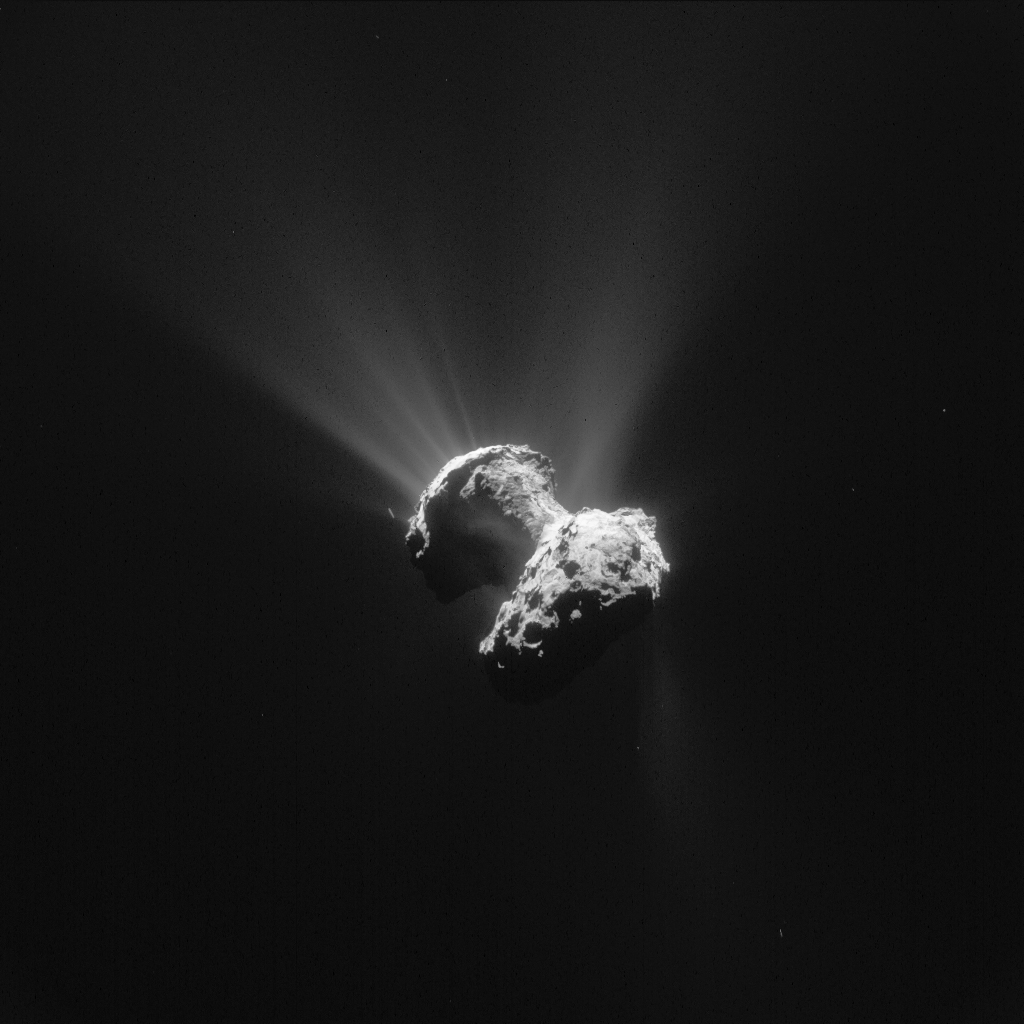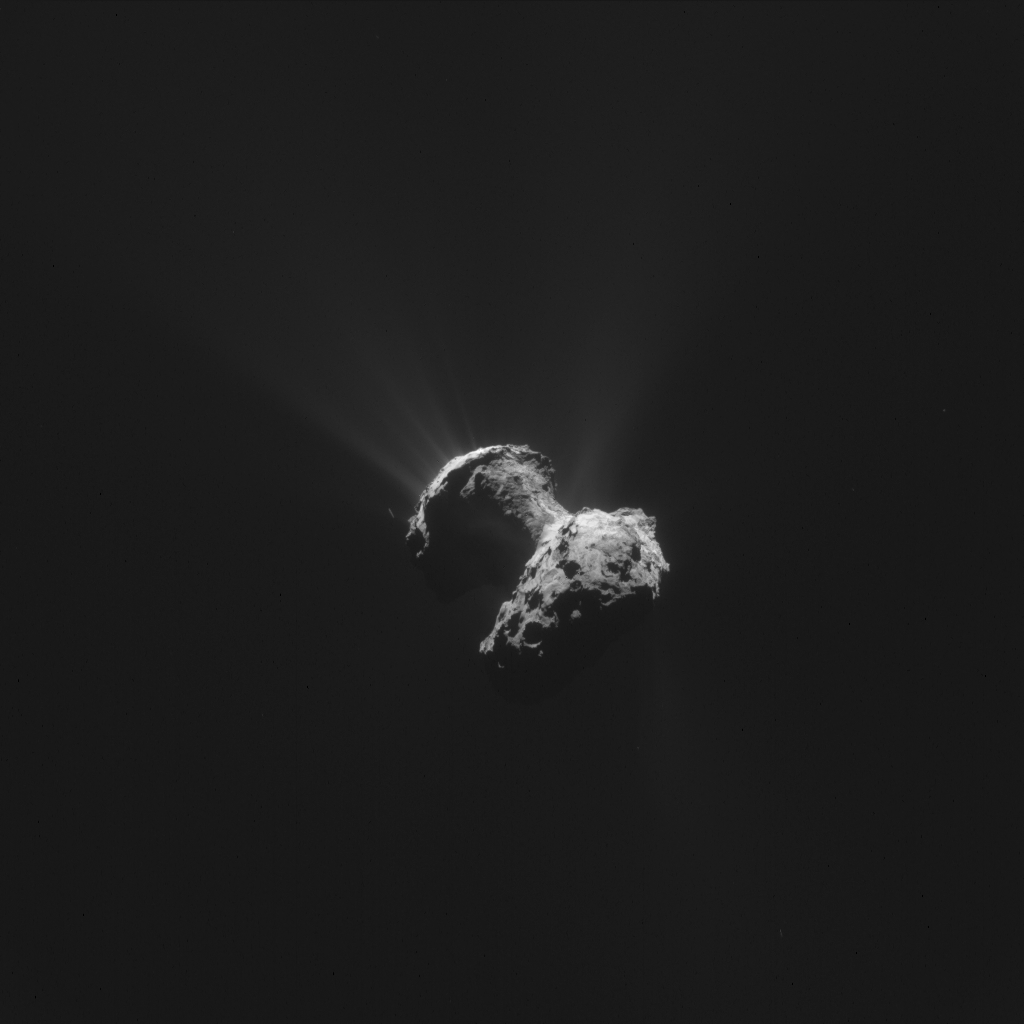Today’s CometWatch entry is a single frame NAVCAM image taken on 21 June, when Rosetta was 177 km from the centre of Comet 67P/Churyumov-Gerasimenko. The resolution is 15.1 m/pixel and the image measures 15.4 km across.

Comet 67P/C-G as viewed on 21 June 2015 from a distance of 177 km to the comet centre. Credits: ESA/Rosetta/NAVCAM – CC BY-SA IGO 3.0
This orientation shows the small comet lobe to the top left, and the large lobe to the bottom right. The image was processed in LightRoom to enhance the comet’s activity, which is evident all around the nucleus but appears especially dramatic in the top part of the image.
On the small lobe, the small Serqet region is lit, with its sharp edge separating it from the rough terrains of Anuket, on the comet’s neck. At the bottom of Anuket, parts of the smooth Hapi region are visible, while the cliffs of Hathor – also on the neck – are cast in shadow. A diffuse luminosity, likely due to the comet’s activity, can be seen also near Hathor.
The large lobe reveals parts of the Seth region, with its characteristic circular features, bordered towards the lower edge by Ash and to the right by the smooth terrains of Anubis. Beyond Anubis, to the far right, is the complex region Atum, and hints of the comet’s activity seem to extend below its edge.
Meanwhile, 541 new images have been added to the NAVCAM Archive Image Browser covering the period from 22 November to 19 December 2014, when Rosetta was approximately 20-30 km from the comet centre. Here is a preview of some of the newly released images:
The original 1024 x 1024 image of today’s CometWatch is provided below:











Discussion: 12 comments
Stylish. Duck with spikey punk Mohawk.
Anyone have an explanation for the steadiness of the jets? Never seen a picture of a jet where it sputters, or varies visually at all in volume of dust output from top to bottom. Instead there is an amazing consistency to them, a completely steady output of dust over long periods of time, which in addition to often being parallel to other jets, seems quite odd.
The jets are mainly caused by the solar wind: which is generally pretty constant. The reason that the jets are parallel is because the force causing them emanates from only one direction: from the sun. As the sun is a very long way away, the beams of light are almost parallel (see parallax angles) thus the same is for the solar wind. There will be a small amount of “stuttering” caused by surface defects on the comet but you are right that you wouldn’t be able to see it. This, I’d guess is mainly a scaling thing. If you look very closely at a “smooth” sheet of paper it appears coarse and grainy but if you zoom out you can see no imperfections.
I’m sorry but this is totally confused nonsense.
Photons are not affected by magnetic fields, bow shocks etc, the solar wind is.
The photons exert a minute force on the dust, important in tail formation, but the force they exert on the surface is completely negligible; the direction they arrive from is irrelevant in that sense, they just heat the comet.
The solar wind is completely incapable of generating the jets; it’s power density is many, many orders of magnitude less than the photon power, and no mechanism exists for it to do so; sputter yield from keV protons are very low, and cannot form molecular water.
I’m afraid my previous comment was typed out rather fast!!! What you say seems accurate, although I think that my confusion arose from the fact that I simplified the jets down to the same mechanism as the gas tail: streams of plasma (and not dust). Thank you very much for your observations and I will certainly do more research into this. Am I right that what you are saying is that it is light from the sun (rather than the solar wind) that generate the dust streams? In that case, I don’t quite understand how the angle of the light rays with respect to the comet plays no part in the fact that the jets appear parallel. Is there another mechanism at play here? Thank you again for your thoughtful comments Harvey.
I don’t find that odd at all in an environment where you have a constant source of energy (sunlight) that’s powering the jets and little to no interference from other factors such as gravity or an atmosphere.
Hi Eric, actually seems like a lot of variables impacting the jets by sublimation – different types of volatiles, different composition/densities of solids, different mixes of volatiles vs solids, varying degrees of sunlight based on rotation, length of time in the sun, sizes and depths of openings, etc, etc. As the most recent post says, the interior of the comet is supposedly “chaotic and diverse,” seems the visible evidence of the sublimation should reflect this.
Looks to me like a ususal laminar flow, on the large scale:
https://en.wikipedia.org/wiki/Laminar_flow
Surface and (shallow) subsurface material is continuously sublimating and decomposing, driven by solar heat.
I don’t see virulent events, although those wouldn’t be quite unexpected.
Gerald, I know I keep saying this about several different thigs, but remember that laminar flow is a *viscous flow* effect.
At a pretty short distance from the comet – dont know quite how far because I dont have a pressure profile – the gas will be in *molecular* flow.
Then laminr, turbulent flow have no meaning any more.
At what pressure you ‘transition to molecular flow’ depends on the scale size you are considering; once the mean free path is of the order of the scale size, you transition to molecular flow.
By 10^-2 Pa, MFP is up to ~10cm, 10^-5Pa its ten metres or so (depending on species & root temperature.)
https://en.wikipedia.org/wiki/Mean_free_path
Unless you’ve been involved in high vacuum system design, behaviour in molecular flow can be very counter intuitive.
Have we heard anything more from Philae yet?
No, long distance and some comm hardware quickly deteriorating. But Teams have not given up.
ok
What an achievement of the Rosetta Team !
Congratulations !
PLUS EST EN VOUS …. Mesdames et Messieurs ! ! !
Lodewijk van Gruuthuse (ca. 1422 – 1492) Bruges